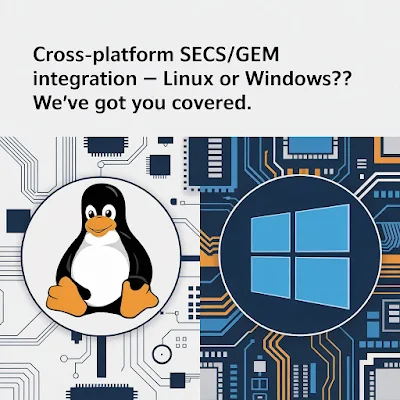The modern manufacturing landscape is undergoing a profound transformation, driven by the relentless pursuit of efficiency, automation, and data-driven decision-making. At the heart of this evolution lies the concept of smart manufacturing, where interconnected systems and data analytics converge to optimize production processes. A critical component of this smart manufacturing ecosystem is the SECS/GEM standard, a vital communication protocol for semiconductor and other manufacturing industries. However, to truly unlock the potential of SECS/GEM, manufacturers are increasingly turning to the cloud.
Cloud computing offers unparalleled scalability, flexibility, and accessibility, making it an ideal platform for managing and analyzing the vast amounts of data generated by modern manufacturing facilities. This blog post explores how SECS/GEM can effectively leverage cloud computing to enhance operational efficiency, improve product quality, and drive innovation.
Bridging the Gap: Integrating SECS/GEM with the Cloud
The SECS/GEM protocol, designed for equipment communication in manufacturing environments, has traditionally operated within localized, on-premise systems. However, the cloud presents a transformative opportunity to extend the reach and capabilities of SECS/GEM Communication. By migrating SECS/GEM Software and data to the cloud, manufacturers can centralize data storage, streamline data analysis, and facilitate real-time monitoring of production processes from anywhere in the world.
One of the key benefits of cloud integration is the ability to scale resources on demand. As production volumes fluctuate, manufacturers can easily adjust their cloud storage and computing capacity, ensuring optimal performance and cost efficiency. This scalability is particularly crucial for handling the massive data streams generated by GEM300 compliant equipment, which are designed for high-volume, automated manufacturing.
Furthermore, cloud-based SECS/GEM Communication Protocol solutions can facilitate seamless data sharing and collaboration across different departments and locations. This centralized data access empowers engineers, operators, and managers to make informed decisions based on real-time insights, leading to improved process optimization and reduced downtime. Cloud platforms also enable the implementation of advanced analytics and machine learning algorithms, which can identify patterns, predict equipment failures, and optimize production parameters.
Enhancing Efficiency and Quality Through Cloud-Enabled SECS/GEM Integration
The SECS/GEM Interface acts as the bridge between manufacturing equipment and the broader information systems. By moving this interface to the cloud, manufacturers can enhance its flexibility and accessibility. Cloud-based SECS/GEM Integration allows for remote monitoring and control of equipment, enabling proactive maintenance and troubleshooting. This remote access is especially valuable for facilities with geographically dispersed operations or those requiring 24/7 monitoring.
Moreover, cloud-based data storage and analysis can significantly improve product quality. By analyzing historical data and real-time process parameters, manufacturers can identify and address potential quality issues before they escalate. This proactive approach to quality control reduces scrap rates, improves yield, and enhances customer satisfaction.
The benefits of cloud integration extend beyond operational efficiency and quality control. Cloud platforms also provide a secure and reliable environment for storing sensitive manufacturing data. Cloud providers invest heavily in security measures, ensuring data integrity and protecting against unauthorized access. This security is critical for maintaining compliance with industry regulations and protecting intellectual property.
The Future of Smart Manufacturing: Leveraging SECS/GEM in the Cloud
As smart manufacturing continues to evolve, the integration of SECS/GEM with cloud computing will become increasingly essential. The cloud provides the infrastructure and tools necessary to harness the power of data, enabling manufacturers to optimize their operations, improve product quality, and drive innovation. By embracing cloud-based solutions, manufacturers can unlock the full potential of SECS/GEM and pave the way for a more efficient and competitive future.
The ability to leverage advanced analytics, machine learning, and AI within a cloud environment, when combined with SECS/GEM Communication, will create new opportunities for predictive maintenance, real-time process optimization, and closed-loop control systems. Ultimately, the synergy between SECS/GEM and cloud computing will empower manufacturers to achieve new levels of efficiency, productivity, and innovation in the era of Industry 4.0.




